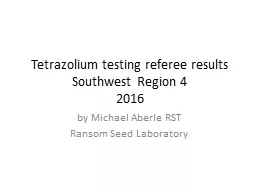

testing referee results Southwest Region 4 2016 by Michael Aberle RST Ransom Seed Laboratory Tetrazolium testing referee results 2016 40 participants 30 laboratories 35 of the respondents were from the West coast region 4 ID: 550725
Download Presentation The PPT/PDF document "Tetrazolium" is the property of its rightful owner. Permission is granted to download and print the materials on this web site for personal, non-commercial use only, and to display it on your personal computer provided you do not modify the materials and that you retain all copyright notices contained in the materials. By downloading content from our website, you accept the terms of this agreement.
Slide1
Tetrazolium testing referee resultsSouthwest Region 42016
by Michael
Aberle
RST
Ransom
Seed LaboratorySlide2
Tetrazolium testing referee results2016
40 participants
30 laboratories
35%
of the respondents were from the West coast region 4
20 photographs
8 plant families Slide3
1. BLUE FLAX
Linum
lewisii
Linaceae
98% viable
Respondents that answered viable:
Concern that the radicle was damagedSlide4
2. BLUE
FLAX
Linum
lewisii
Linaceae
100% non-viableSlide5
3. BLUE
FLAX
Linum
lewisii
Linaceae
98% non-viable
Respondents that answered viable:
Concern that a membrane covered the unstained partsSlide6
4
. CACTUS
Cactaceae
100% non-viableSlide7
5
. CACTUS
Cactaceae
95%
viable
Respondents that answered non-viable:
Concern that there was a crack in the embryoSlide8
6. Flowering kale
Brassica
oleracea
Brassicaceae
52%
viable
Respondents that answered non-viable:
Concern that necrosis reached the juncture of the cotyledons and the embryo axisSlide9
7. Flowering
kale
Brassica
oleracea
Brassicaceae
90%
viable
Respondents that answered non-viable:
Concern that the radicle was broken
Concern that there was insufficient staining Slide10
8. Flowering
kale
Brassica
oleracea
Brassicaceae
87
%
non-viable
Respondents that answered viable:
Concern that the necrosis is only superficial
Embryo axis is not damaged
Non-essential areas unstainedSlide11
9. Flowering
kale
Brassica
oleracea
Brassicaceae
100% non-viableSlide12
10. LOVAGE
Levisticum
officinale
Apiaceae
82% non-viable
Respondents that answered viable:
Concern that embryo might have a light stain
Could be dormant as in AOSA/SCST TZ Handbook where there is the case of an unstained embryo with stained endosperm Slide13
11. LOVAGE
Levisticum
officinale
Apiaceae
100%
viableSlide14
12. NASTURTIUM
Tropaeolum
majus
Tropaeolaceae
95% non-viable
Respondents that answered viable:
Concern that the embryo stained lightly Slide15
13. NASTURTIUM
Tropaeolum
majus
Tropaeolaceae
65% non-viable
Respondents that answered viable:
Could not relate the image to the example given in the AOSA/SCST TZ Handbook
Unstained areas are minorSlide16
14. OREGANO
Origanum
vulgare
Lamiaceae
98% non-viable
Respondents that answered viable:
Saw uniform stainSlide17
15. OREGANO
Origanum
vulgare
Lamiaceae
100%
viableSlide18
16.
Phormium
sp.
Xanthorrhoeaceae
[
Agavaceae
]
100%
viableSlide19
17.
Phormium
sp
.
Xanthorrhoeaceae
[
Agavaceae
]
98% non-viable
Respondents that answered viable:
Saw more than half the embryo stainedSlide20
18.
Phormium
sp.
Xanthorrhoeaceae
[
Agavaceae
]
95%
viable
Respondents that answered non-viable:
Concerned that the endosperm was unstained (light reflecting off the seed made it look unstained)Slide21
19. SUNFLOWER
Helianthus
annuus
Asteraceae
90% non-viable
Respondents that answered viable:
Concern that the damage at the root tip was minimal
More than half the embryo stained
In the AOSA/SCST TZ Handbook slight damage to the root tip is acceptable Slide22
20. SUNFLOWER
Helianthus
annuus
Asteraceae
90%
viable
Respondents that answered non-viable:
Concern over the dark spots on the radicle
Unstained cotyledon Slide23
21. SUNFLOWER
Helianthus
annuus
Asteraceae
100% non-viableSlide24
22. SUNFLOWER
Helianthus
annuus
Asteraceae
100% non-viable